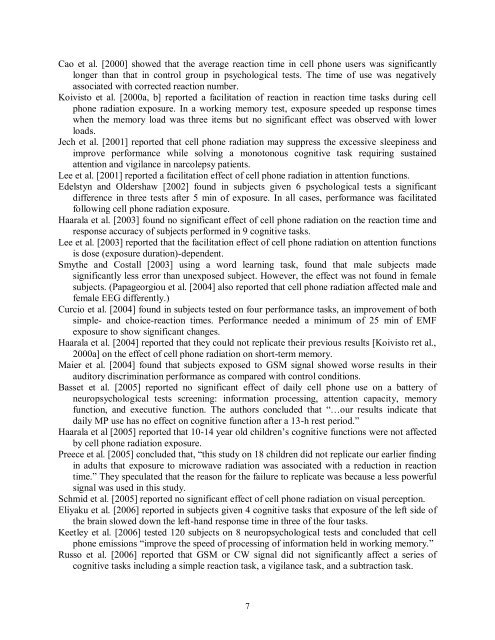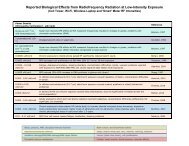Evidence for Effects on Neurology and Behavior - BioInitiative Report
Evidence for Effects on Neurology and Behavior - BioInitiative Report
Evidence for Effects on Neurology and Behavior - BioInitiative Report
Create successful ePaper yourself
Turn your PDF publications into a flip-book with our unique Google optimized e-Paper software.
Cao et al. [2000] showed that the average reacti<strong>on</strong> time in cell ph<strong>on</strong>e users was significantly<br />
l<strong>on</strong>ger than that in c<strong>on</strong>trol group in psychological tests. The time of use was negatively<br />
associated with corrected reacti<strong>on</strong> number.<br />
Koivisto et al. [2000a, b] reported a facilitati<strong>on</strong> of reacti<strong>on</strong> in reacti<strong>on</strong> time tasks during cell<br />
ph<strong>on</strong>e radiati<strong>on</strong> exposure. In a working memory test, exposure speeded up resp<strong>on</strong>se times<br />
when the memory load was three items but no significant effect was observed with lower<br />
loads.<br />
Jech et al. [2001] reported that cell ph<strong>on</strong>e radiati<strong>on</strong> may suppress the excessive sleepiness <strong>and</strong><br />
improve per<str<strong>on</strong>g>for</str<strong>on</strong>g>mance while solving a m<strong>on</strong>ot<strong>on</strong>ous cognitive task requiring sustained<br />
attenti<strong>on</strong> <strong>and</strong> vigilance in narcolepsy patients.<br />
Lee et al. [2001] reported a facilitati<strong>on</strong> effect of cell ph<strong>on</strong>e radiati<strong>on</strong> in attenti<strong>on</strong> functi<strong>on</strong>s.<br />
Edelstyn <strong>and</strong> Oldershaw [2002] found in subjects given 6 psychological tests a significant<br />
difference in three tests after 5 min of exposure. In all cases, per<str<strong>on</strong>g>for</str<strong>on</strong>g>mance was facilitated<br />
following cell ph<strong>on</strong>e radiati<strong>on</strong> exposure.<br />
Haarala et al. [2003] found no significant effect of cell ph<strong>on</strong>e radiati<strong>on</strong> <strong>on</strong> the reacti<strong>on</strong> time <strong>and</strong><br />
resp<strong>on</strong>se accuracy of subjects per<str<strong>on</strong>g>for</str<strong>on</strong>g>med in 9 cognitive tasks.<br />
Lee et al. [2003] reported that the facilitati<strong>on</strong> effect of cell ph<strong>on</strong>e radiati<strong>on</strong> <strong>on</strong> attenti<strong>on</strong> functi<strong>on</strong>s<br />
is dose (exposure durati<strong>on</strong>)-dependent.<br />
Smythe <strong>and</strong> Costall [2003] using a word learning task, found that male subjects made<br />
significantly less error than unexposed subject. However, the effect was not found in female<br />
subjects. (Papageorgiou et al. [2004] also reported that cell ph<strong>on</strong>e radiati<strong>on</strong> affected male <strong>and</strong><br />
female EEG differently.)<br />
Curcio et al. [2004] found in subjects tested <strong>on</strong> four per<str<strong>on</strong>g>for</str<strong>on</strong>g>mance tasks, an improvement of both<br />
simple- <strong>and</strong> choice-reacti<strong>on</strong> times. Per<str<strong>on</strong>g>for</str<strong>on</strong>g>mance needed a minimum of 25 min of EMF<br />
exposure to show significant changes.<br />
Haarala et al. [2004] reported that they could not replicate their previous results [Koivisto ret al.,<br />
2000a] <strong>on</strong> the effect of cell ph<strong>on</strong>e radiati<strong>on</strong> <strong>on</strong> short-term memory.<br />
Maier et al. [2004] found that subjects exposed to GSM signal showed worse results in their<br />
auditory discriminati<strong>on</strong> per<str<strong>on</strong>g>for</str<strong>on</strong>g>mance as compared with c<strong>on</strong>trol c<strong>on</strong>diti<strong>on</strong>s.<br />
Basset et al. [2005] reported no significant effect of daily cell ph<strong>on</strong>e use <strong>on</strong> a battery of<br />
neuropsychological tests screening: in<str<strong>on</strong>g>for</str<strong>on</strong>g>mati<strong>on</strong> processing, attenti<strong>on</strong> capacity, memory<br />
functi<strong>on</strong>, <strong>and</strong> executive functi<strong>on</strong>. The authors c<strong>on</strong>cluded that “…our results indicate that<br />
daily MP use has no effect <strong>on</strong> cognitive functi<strong>on</strong> after a 13-h rest period.”<br />
Haarala et al [2005] reported that 10-14 year old children’s cognitive functi<strong>on</strong>s were not affected<br />
by cell ph<strong>on</strong>e radiati<strong>on</strong> exposure.<br />
Preece et al. [2005] c<strong>on</strong>cluded that, “this study <strong>on</strong> 18 children did not replicate our earlier finding<br />
in adults that exposure to microwave radiati<strong>on</strong> was associated with a reducti<strong>on</strong> in reacti<strong>on</strong><br />
time.” They speculated that the reas<strong>on</strong> <str<strong>on</strong>g>for</str<strong>on</strong>g> the failure to replicate was because a less powerful<br />
signal was used in this study.<br />
Schmid et al. [2005] reported no significant effect of cell ph<strong>on</strong>e radiati<strong>on</strong> <strong>on</strong> visual percepti<strong>on</strong>.<br />
Eliyaku et al. [2006] reported in subjects given 4 cognitive tasks that exposure of the left side of<br />
the brain slowed down the left-h<strong>and</strong> resp<strong>on</strong>se time in three of the four tasks.<br />
Keetley et al. [2006] tested 120 subjects <strong>on</strong> 8 neuropsychological tests <strong>and</strong> c<strong>on</strong>cluded that cell<br />
ph<strong>on</strong>e emissi<strong>on</strong>s “improve the speed of processing of in<str<strong>on</strong>g>for</str<strong>on</strong>g>mati<strong>on</strong> held in working memory.”<br />
Russo et al. [2006] reported that GSM or CW signal did not significantly affect a series of<br />
cognitive tasks including a simple reacti<strong>on</strong> task, a vigilance task, <strong>and</strong> a subtracti<strong>on</strong> task.<br />
7



